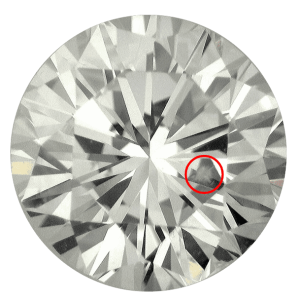Diamonds, the product of immense pressure and heat over a significant timespan, bear silent testimony to the geological events that led to their creation. These sparkling gems are frequently lauded for their clarity, but inclusions, the microscopic internal characteristics, often add unique beauty and character to each diamond. One such intriguing inclusion is the “Bruise.”
A Bruise, in gemological parlance, refers to an area of impact on a diamond, where the crystal lattice has been disturbed or damaged. Though the term might evoke images of harm, this specific kind of inclusion actually conveys a history of interaction with the world outside the diamond’s primordial birthplace. A diamond with a Bruise is not merely a gemstone, but a geological artifact bearing the imprints of its journey.
Formation of Bruises in Diamonds
Understanding the formation of Bruises begins with grasping the diamond’s crystal structure. Diamonds are composed of carbon atoms arranged in a highly organized lattice structure, rendering them the hardest known material on earth. However, despite their unrivaled hardness, diamonds are not immune to potential damage, especially if they encounter a sharp blow with sufficient force.
When such an event happens, it can disturb the precise and highly organized crystal lattice of the diamond, creating a dislocation or alteration in the arrangement of carbon atoms. This results in the formation of what gemologists describe as a Bruise. Often, Bruises are associated with feathers, which are small fractures within the diamond. When a blow is sufficiently strong, it may cause a feather to form, with a Bruise at the point of impact.
Detection and Impact of Bruises on Diamonds
Bruises can be challenging to detect without specialized gemological equipment. Under a jeweler’s loupe or a microscope, a Bruise might appear as a tiny, hazy area, often associated with small, hair-like fractures radiating outwards. Despite their minuscule size, Bruises can impact a diamond’s clarity grade and subsequently its value.
The Gemological Institute of America (GIA), one of the world’s most respected diamond grading organizations, considers inclusions like Bruises when determining a diamond’s clarity grade. The size, number, position, nature, and color of the inclusions are all factors in the final assessment.
It’s important to note, though, that many Bruises are not visible to the naked eye and do not significantly detract from the overall appearance of the diamond. Indeed, some individuals even prefer diamonds with unique inclusions, as they can serve as a natural fingerprint, making their diamond distinct and easily identifiable.
The Fascinating Beauty of Bruises
While diamonds with fewer inclusions are traditionally more prized, there’s a growing appreciation for the unique beauty and character that these internal features can provide. Each Bruise tells a story of the diamond’s journey from its formation deep in the earth, through its tumultuous journey to the surface, to the cutting and polishing process.
Though they may affect the clarity grade, Bruises can add a layer of depth and fascination to the diamond. As with all inclusions, the unique constellation of Bruises and other features within a diamond makes it a one-of-a-kind piece, a small but tangible record of the vast geological forces that created it.
Conclusion: Bruises – Markings of a Diamond’s Journey
In essence, a Bruise is a testament to a diamond’s resilience, an imprint of an encounter that it withstood despite the odds. It’s an inclusion that doesn’t take away from the diamond’s appeal but adds to its intrigue. In an era where the unique is increasingly cherished, understanding and appreciating Bruises in diamonds illuminate the fact that these gemstones are more than just symbols of luxury. They are intricate narratives of earth’s incredible geological processes, frozen in time, waiting to be admired and appreciated in all their imperfect perfection.
